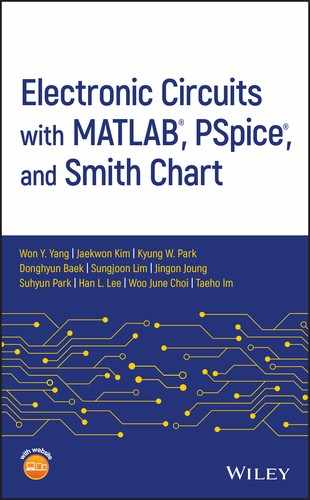Appendix C
Complex Number Operations with MATLAB
C.1 Addition
(C.1)
C.2 Multiplication
(C.2a)
(C.2b)
C.3 Division
(C.3a)
(C.3b)

C.4 Conversion between Rectangular Form and Polar/Exponential Form
(C.4)
Here, r and θ are referred to as the absolute value and argument or phase angle of complex number ar+jai, respectively, and j is the unit imaginary number ![]() .
.
C.5 Operations on Complex Numbers Using MATLAB
If we do not use i and j for any other purpose, they represent the basic imaginary unit ![]() by default. Try typing the following statements into the MATLAB Command Window.
by default. Try typing the following statements into the MATLAB Command Window.
>>c1= 1+2i; c2= 3-4i;>>c1*c2 % multiplication of complex numbers>>c1/c2 % division of complex numbers>>r=abs(c2) % absolute value of the complex number c2>>sqrt(real(c2)^2+imag(c2)^2) % equivalent to the absolute value>>th=angle(c2) % phase angle of the complex number c2 in radians>>atan2(imag(c2),real(c2)) % equivalent to the phase angle>>imag(log(c2)) % equivalent to the phase angle>>th*180/pi % radian-to-degree conversion>>r*exp(j*th) % polar-to-rectangular conversionans = 3.0000 - 4.0000i>>C= [1+i 1-2i; -1+3i -1-4i] % a complex matrixC = 1.0000 + 1.0000i 1.0000 - 2.0000i-1.0000 + 3.0000i -1.0000 - 4.0000i>>C1= C' % conjugate transposeC1 = 1.0000 - 1.0000i -1.0000 - 3.0000i1.0000 + 2.0000i -1.0000 + 4.0000i
..................Content has been hidden....................
You can't read the all page of ebook, please click here login for view all page.
